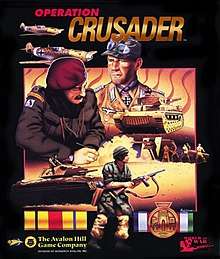Operation Crusader (video game)
Operation Crusader is a 1994 computer wargame developed by Atomic Games and published by Avalon Hill.
| Operation Crusader | |
|---|---|
 Cover art | |
| Developer(s) | Atomic Games |
| Publisher(s) | Avalon Hill |
| Platform(s) | DOS, Macintosh |
| Release |
|
| Genre(s) | Strategy |
Operation Crusader was among the first titles released in Avalon Hill's push to revive its computer game division during the 1990s, in an attempt to diversify its business because of falling board wargame sales. The company hired Atomic Games as a key to this initiative, and Crusader acted as the spiritual success to its earlier V for Victory (video game) wargame series, reusing and updating much of the game design and code from those titles.
Gameplay
Development

Starting with the hire of producer Jim Rose in December 1992,[1][2] Avalon Hill began an effort to revive its computer game branch in response to flagging board wargame sales during the 1990s.[3][4] Rose signed developer Atomic Games in 1993 as a key part of this initiative.[5][6][3] The Atomic team was known for the V for Victory series with Three-Sixty Pacific, but had recently left that publisher,[5] after a period of financial problems that culminated in a lawsuit for unpaid royalties.[7][8] While Avalon contracted Atomic primarily to create a computer version of Advanced Squad Leader,[5][9] Alan Emrich of Computer Gaming World reported rumors in 1993 that "Avalon Hill will [also] be publishing a second game from Atomic" centered on the North African Campaign. He speculated that this was "what would be the next V for Victory game in an Avalon Hill wrapper".[5] By January 1994, Atomic Games had revealed the World at War series as the successor to its V for Victory line under Avalon, and its first entry was entitled Operation Crusader.[10]
Alongside Kingmaker, Operation Crusader was one of the first two titles released as part of Avalon Hill's new initiative.[4][3] The computer game division had previously been known for low-quality titles,[3][2][11] a problem that Avalon Hill's Don Greenwood blamed on his and the company's "hubris" and favoritism toward board products.[3] Ross Hetrick of the Baltimore Sun reported that the company's first venture ran from 1983 to 1986, and ended "when its games began to lag those of competitors."[4] For Operation Crusader, Zabalaoui noted that Avalon Hill's president had informed him that " 'good' isn't good enough".[6]
Atomic and Avalon Hill experienced creative friction during the development of Operation Crusader.[12][13][14]Computer Gaming World columnist Alan Emrich wrote in 1995, "To say there was no love lost between [...] Jim Rose and Atomic's Keith Zabalaoui would be a gracious understatement."[14] However, the magazine's Terry Coleman noted that the "tensions" between the companies' design philosophies "worked positively" on Operation Crusader.[12]
Operation Crusader was released in 1994, between April and June.[4]
Reception
In PC Gamer US, William R. Trotter called Operation Crusader "a thoroughbred and a champion", and awarded it a score of 94%.[11] Czech magazine Score rated the game 6 out of 10.[15]
Trotter went on to name Operation Crusader one of his favorite titles of 1994, and wrote that it "captured all the sweep, fluidity, and sudden reversals-of-fortune that characterized the desert war."[16] The game was also a runner-up for Computer Gaming World's 1994 "Wargame of the Year" prize, which ultimately went to Panzer General. The editors remarked that Crusader "one-ups Atomic Games' V for Victory series in terms of both graphics and gameplay."[17] In 1996, the magazine declared it the 110th-best computer game ever released.[18]
References
- Rose, Jim (1993). "Silicon Simulations". The General. 28 (4): 57.
- Trotter, William R. (December 1995). "The Desktop General; Avalon Hill: On the Ropes or On a Roll?". PC Gamer US. 2 (12): 303, 304.
- Greenwood, Don (1994). "The Avalon Hill Philosophy Part 161: A Tale of Two Companies". The General. 29 (2): 3.
- Hetrick, Ross (June 13, 1994). "Getting Back Into The Battle". Baltimore Sun. Archived from the original on March 25, 2016.
- Emrich, Alan (November 1993). "How Goes the Battle?". Computer Gaming World (112): 164.
- Hawthorne, Don (1993). "Silicon Simulations". The General. 29 (1): 54, 55.
- Staff (February 1995). "Eyewitness; V for Lawsuit". PC Gamer US. 2 (2): 32, 33.
- Frisina, Tom (March 1995). "Eyewitness; V for Victory — Continued". PC Gamer US. 2 (3): 42.
- Zabalaoui, Keith (December 4, 1998). "Designer Diaries: Close Combat III". GameSpot. Archived from the original on April 28, 1999.
- Zabalaoui, Keith; Wesevich, Jeff (January 1994). "Operation Crusader: Designer's Notes". Computer Games Strategy Plus. Atomic Games. Archived from the original on June 14, 1997. Retrieved April 25, 2020.CS1 maint: uses authors parameter (link)
- Trotter, William R. (December 1994). "Review of Operation Crusader in PC Gamer Magazine". PC Gamer US. Atomic Games. Archived from the original on June 14, 1997. Retrieved April 25, 2020.
- Coleman, Terry (January 1999). "Close Combat III; Atomic for Power, Turbines for Speed". Computer Gaming World (174): 82, 83, 86.
- Trotter, William R. (December 1995). "The Desktop General; Avalon Hill: On the Ropes or On a Roll?". PC Gamer US. 2 (12): 303, 304.
- Emrich, Alan (November 1995). "Turning the Telescope Around; G-2". Computer Gaming World (136): 253, 254, 256.
- https://www.oldgames.sk/en/mag/score-21/page/36/
- Trotter, William R. (February 1995). "The Desktop General; The Best and the Worst of 1994". PC Gamer US. 2 (2): 133.
- Staff (May 1995). "The Computer Gaming World 1995 Premier Awards". Computer Gaming World (130): 35, 36, 38, 40, 42, 44.
- Staff (November 1996). "150 Best (and 50 Worst) Games of All Time". Computer Gaming World (148): 63–65, 68, 72, 74, 76, 78, 80, 84, 88, 90, 94, 98.